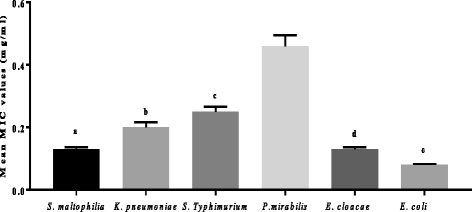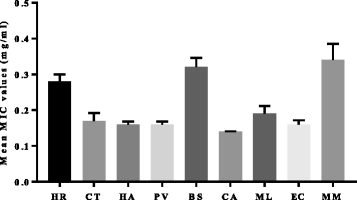Potency and selectivity indices of acetone leaf extracts of nine selected South African trees against six opportunistic Enterobacteriaceae isolates from commercial chicken eggs
- PMID: 28148263
- PMCID: PMC5289020
- DOI: 10.1186/s12906-017-1597-3
Potency and selectivity indices of acetone leaf extracts of nine selected South African trees against six opportunistic Enterobacteriaceae isolates from commercial chicken eggs
Abstract
Background: The rise in antimicrobial resistance in a plethora of nosocomial and opportunistic bacterial pathogens often isolated from commercial eggs, poses a serious public health concern. The existence of these contaminants may also serve as a drawback in the current efforts of improving the well-being of immunocompromised patients. The aim of this study was to determine the efficacy of plant extracts that had good activity on Escherichia coli in previous word on pathogens isolated from eggs for possible use in combating pathogens from eggs.
Methods: Acetone leaf extracts of nine trees with good activities against Escherichia coli were tested for their in vitro antibacterial activity against six opportunistic bacterial isolates from commercial eggs (Stenotrophomonas maltophilia, Klebsiella pneumoniae, Salmonella serotype Typhimurium, Proteus mirabilis, Enterobacter cloacae and Escherichia coli) using a serial microdilution method with tetrazolium violet as indicator of growth. Cytotoxicity was determined using a tetrazolium-based colorimetric assay against Vero kidney cells, and selectivity index calculated.
Results: The MIC values range of the different extracts against Stenotrophomonas maltophilia was 0.08-0.31 mg/ml, Klebsiella pneumonia 0.08-0.63 mg/ml, Salmonella ser. Typhimurium 0.08-0.63 mg/ml, Proteus mirabilis 0.02-1.25 mg/ml, Enterobacter cloacae 0.08-0.31 mg/ml and Escherichia coli 0.08-0.16 mg/ml respectively. Escherichia coli was the most sensitive while Proteus mirabilis was most resistant pathogen to the different test extracts, with mean MIC values of 0.08 mg/ml and 0.46 mg/ml respectively. Cremaspora triflora extracts had good activity against all the pathogenic egg isolates, with the exception of Proteus mirabilis. Maesa lanceolata and Elaeodendron croceum had the best total antibacterial activity (TAA), while generally the selectivity index of the extract was low (SI < 1).
Conclusion: The exceptional activity of C. triflora extracts suggests that the plant has potential as a therapeutic agent against some members of the Enterobacteriaceae. Further pharmacological investigations may be interesting in the search for new antimicrobial leads.
Keywords: Antimicrobial; Hens’ egg isolates; Nosocomial; Opportunistic pathogens; Plant extracts.
Figures


Similar articles
-
The antibacterial activity of extracts of nine plant species with good activity against Escherichia coli against five other bacteria and cytotoxicity of extracts.BMC Complement Altern Med. 2017 Feb 28;17(1):133. doi: 10.1186/s12906-017-1645-z. BMC Complement Altern Med. 2017. PMID: 28241818 Free PMC article.
-
Acetone leaf extracts of some South African trees with high activity against Escherichia coli also have good antimycobacterial activity and selectivity index.BMC Complement Altern Med. 2017 Jun 19;17(1):327. doi: 10.1186/s12906-017-1831-z. BMC Complement Altern Med. 2017. PMID: 28629354 Free PMC article.
-
The efficacy and safety of nine South African medicinal plants in controlling Bacillus anthracis Sterne vaccine strain.BMC Complement Altern Med. 2016 Jan 8;16:5. doi: 10.1186/s12906-015-0980-1. BMC Complement Altern Med. 2016. PMID: 26742484 Free PMC article.
-
Antibacterial and antibiofilm activity of acetone leaf extracts of nine under-investigated south African Eugenia and Syzygium (Myrtaceae) species and their selectivity indices.BMC Complement Altern Med. 2019 Jun 20;19(1):141. doi: 10.1186/s12906-019-2547-z. BMC Complement Altern Med. 2019. PMID: 31221162 Free PMC article.
-
Antibacterial activity and mode of action of acetone crude leaf extracts of under-investigated Syzygium and Eugenia (Myrtaceae) species on multidrug resistant porcine diarrhoeagenic Escherichia coli.BMC Vet Res. 2019 May 22;15(1):162. doi: 10.1186/s12917-019-1914-9. BMC Vet Res. 2019. PMID: 31118023 Free PMC article.
Cited by
-
Isolation and Characterization of Galloylglucoses Effective against Multidrug-Resistant Strains of Escherichia coli and Klebsiella pneumoniae.Molecules. 2022 Aug 8;27(15):5045. doi: 10.3390/molecules27155045. Molecules. 2022. PMID: 35956993 Free PMC article.
-
A comprehensive study of the potential phytomedicinal use and toxicity of invasive Tithonia species in South Africa.BMC Complement Altern Med. 2018 Oct 3;18(1):272. doi: 10.1186/s12906-018-2336-0. BMC Complement Altern Med. 2018. PMID: 30285713 Free PMC article.
-
Influence of Storage Packaging Type on the Microbiological and Sensory Quality of Free-Range Table Eggs.Animals (Basel). 2023 Jun 6;13(12):1899. doi: 10.3390/ani13121899. Animals (Basel). 2023. PMID: 37370410 Free PMC article.
-
The traditional use of southern African medicinal plants for the treatment of bacterial respiratory diseases: A review of the ethnobotany and scientific evaluations.J Ethnopharmacol. 2020 Dec 5;263:113204. doi: 10.1016/j.jep.2020.113204. Epub 2020 Jul 27. J Ethnopharmacol. 2020. PMID: 32730881 Free PMC article. Review.
-
Antimicrobial Activity, Antioxidant Potential, Cytotoxicity and Phytochemical Profiling of Four Plants Locally Used against Skin Diseases.Plants (Basel). 2019 Sep 15;8(9):350. doi: 10.3390/plants8090350. Plants (Basel). 2019. PMID: 31540194 Free PMC article.
References
-
- Adesiyun A, Offiah N, Seepersadsingh N, Rodrigo S, Lashley V, Musai L. Frequency and antimicrobial resistance of enteric bacteria with spoilage potential isolated from table eggs. Food Res Int. 2006;39:212–219. doi: 10.1016/j.foodres.2005.07.008. - DOI
-
- Jambalang AR. The development and validation of a bacteriological screening test for antimicrobial residues in eggs. MSc Dissertation. South Africa: University of Pretoria; 2011. http://hdl.handle.net/2263/24843.
-
- Al-Ashmawy MA. Prevalence of Enterobacteriaceae in table eggs with particular reference to enterovirulent Escherichia coli strains. Int J Poult Sci. 2013;12:430–435. doi: 10.3923/ijps.2013.430.435. - DOI
-
- Messens W, Grijspeerdt K, Herman L. Eggshell penetration by Salmonella : a review. Worlds Poult Sci J. 2005;61(March):71–86. doi: 10.1079/WPS200443. - DOI
-
- Adesiyun A, Offiah N, Seepersadsingh N, Rodrigo S, Lashley V, Musai L. Antimicrobial resistance of Salmonella spp. and Escherichia coli isolated from table eggs. Food Control. 2007;18:306–311. doi: 10.1016/j.foodcont.2005.10.013. - DOI
MeSH terms
Substances
LinkOut - more resources
Full Text Sources
Other Literature Sources
Medical

